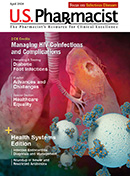There are perhaps just a handful of disease states that spark as much debate as human papillomavirus (HPV) infection. This is due in part to the young age of one of the primary patient populations that HPV impacts, as well as the nature of disease transmission, which is oftentimes through sexual contact.
Prevention and treatment recommendations frequently change. Just last month, the CDC released new vaccine-coverage statistics and HPV treatment guidelines. In its release, the CDC
estimated that despite moving at a sluggish pace, HPV vaccination is still becoming more commonplace. Some six out of 10 teen girls (63%) and five out of 10 teen boys (50%) in the United States, the CDC reported, have started the HPV vaccination series (have received at least one HPV vaccine dose) according to data from the 2015 National Immunization Survey-Teen. Even though more girls than boys are receiving HPV vaccine, says the CDC, this gender gap is nevertheless narrowing.
However, the CDC cautioned in its March release, fewer teens are receiving the HPV vaccine compared to the Tdap and meningococcal vaccines. About eight out of 10 girls and boys have received the Tdap (86%) and meningococcal vaccines (81%). This difference, the agency states, “...highlights missed opportunities to give HPV vaccine during the same visit that other vaccines are given.”
To remedy this, the CDC urges healthcare providers to recommend HPV vaccination for all their 11- and 12-year-old patients—on the same day and in the same way that they recommend other preteen vaccines they routinely administer.
Regardless of these recommendations, providers may find resistance. As Mark Donald White, MD, FACS, wrote a couple of years ago in his article “Pros, cons, and ethics of vaccination in teens—why such controversy?,” published in the journal Translational Andrology and Urology, “There still seems to be controversy surrounding these universal vaccination programs as well as some ethical and practical concerns regarding the administration of a vaccine for diseases that are associated with sexual contact in both sexes, especially during the early adolescent years.”
Despite pushback, it would appear that healthcare providers are justified in persisting with HPV vaccination programs in preteen patients. The scope of the HPV landscape is daunting, and the CDC places the rate of new infections at some 14 million annually in the U.S., with approximately half of these cases presenting in persons aged 15 to 24 years. Moreover, the CDC says that more than half of all sexually active men and women will suffer from at least one variety of HPV infection during their lifetime.
Indeed, HPV is the most common sexually transmitted infection, and, as this issue’s CE article, “HPV Infection and Warts: Review and Recent Updates,” by A. Adesoye, PharmD, BCPS, et al, states, there are currently more than 200 identified types of HPV. These myriad virus varieties cause morbidities ranging from asymptomatic infection to self-limiting warts to abnormalities that end up as various cancers, such as cervical cancer. Many people will not even be aware they are infected, since, as Dr. Adesoye writes, the immune system in these patients typically kills these infections within a couple of years. Nevertheless, a significant number will develop clinically manifested disease.
Effective screening and prevention through vaccines, Dr. Adesoye writes, are key in stemming diseases originating from HPV infections. Pharmacists, she contends, play a vital role in making patients and their sexual partners aware of HPV, screening, and preventive strategies, as well as different treatment modalities.
To comment on this article, contact editor@uspharmcist.com.





